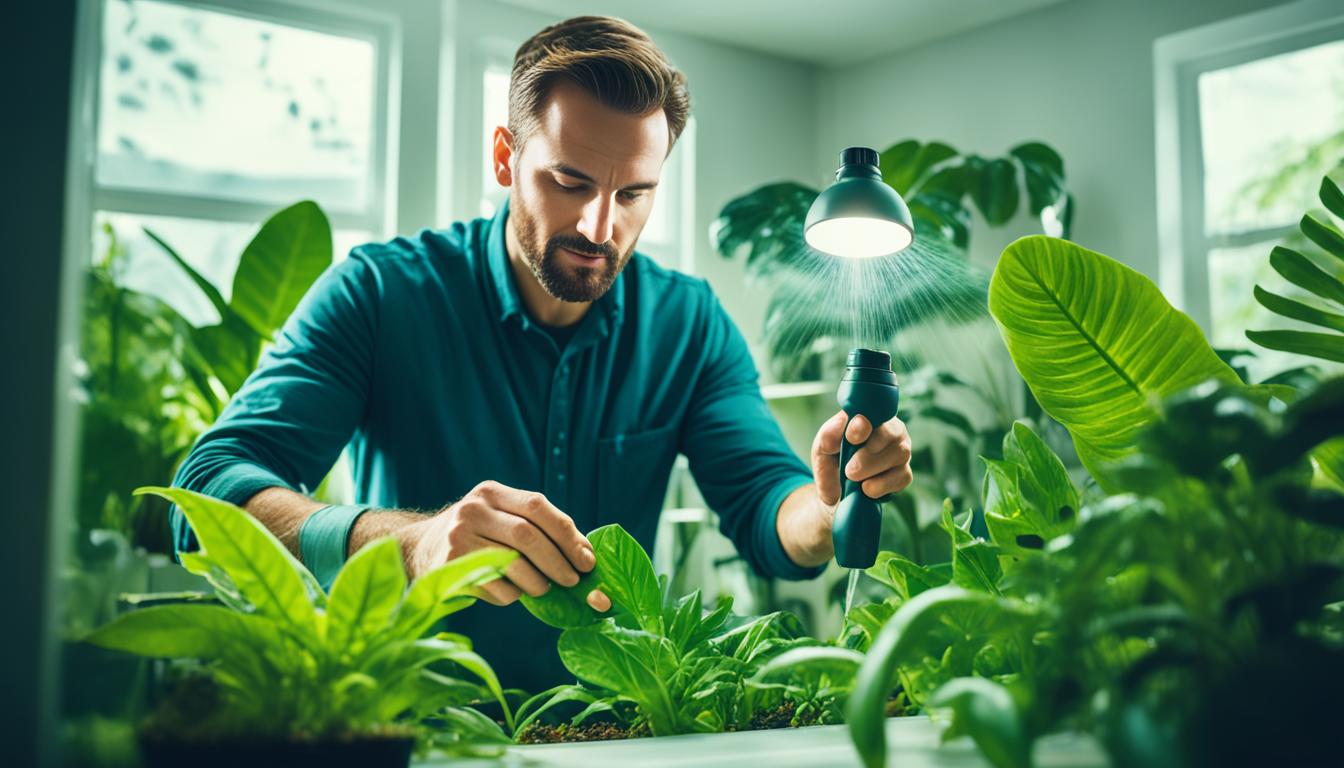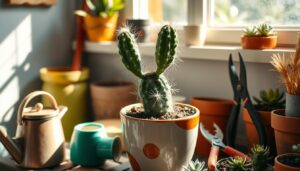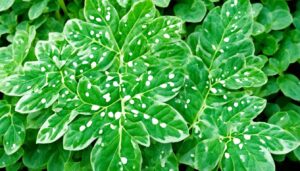Welcome to the fascinating world of exotic and unusual houseplants! Have you ever wondered how to care for these extraordinary botanical gems? Are you ready to elevate your indoor gardening skills and create a green oasis that will leave everyone in awe?
In this comprehensive guide, we will dive deep into the art of exotic houseplant care, equipping you with expert tips and advice to ensure these unique plants thrive in your urban jungle. Whether you’re a gardening enthusiast or new to the world of indoor plants, this article will empower you to unleash your green thumb and transform your living spaces into captivating wonderlands.
So, are you ready to embark on this green journey and uncover the secrets of exotic houseplant care? Let’s get started!
Key Takeaways
- Exotic houseplants can add beauty and benefits to your indoor spaces.
- Proper care for specific plants like the Fiddle Leaf Fig, Monstera Deliciosa, Bird of Paradise, Calathea Orbifolia, and Pink Princess Philodendron will be explored.
- There are pet-friendly and low-maintenance options available for those seeking easy-to-care-for exotic houseplants.
- By understanding the specific needs of these plants and providing the right conditions, you can create a thriving indoor garden.
- Ready to transform your living space into a green oasis? Let’s dive into the world of exotic houseplant care!
The Beauty and Benefits of Exotic Houseplants
Exotic houseplants not only add a touch of beauty to our indoor spaces but also provide a range of benefits. Let’s explore the reasons why incorporating these captivating plants into your home or office is a wise choice.
Clean and Purify the Air
Exotic houseplants are not just visually appealing; they also act as natural air purifiers. These plants remove harmful pollutants from the air, enhancing indoor air quality. They absorb toxins such as formaldehyde, benzene, and xylene from various sources like paint, furniture, and cleaning products. By doing so, they help create a healthier environment for you and your loved ones.
One of the most efficient air-purifying houseplants is the Snake Plant, also known as Sansevieria. It releases oxygen during the night, making it an ideal bedroom companion for promoting better sleep.
Boost Mood and Productivity
Bringing the beauty of exotic houseplants into your living or workspace can positively impact your mood and productivity. Research has shown that being surrounded by greenery has a calming effect, reduces stress, and enhances overall well-being.
Plants such as the Peace Lily (Spathiphyllum) or the Rubber Plant (Ficus elastica) are great choices for creating a peaceful and serene atmosphere. Their lush foliage and subtle fragrance create a tranquil environment that aids relaxation and focus.
Create a Soothing Oasis
Indoor plants have a remarkable ability to create a soothing and vibrant atmosphere. They bring a touch of nature indoors, allowing you to escape the hustle and bustle of daily life and find tranquility in your own space.
One visually striking choice is the Croton (Codiaeum variegatum), renowned for its brightly colored leaves. Its vibrant red, orange, and yellow foliage will brighten up any room and instantly transport you to a tropical paradise.
A Table Displaying the Benefits of Exotic Houseplants:
| Benefits of Exotic Houseplants |
|---|
| Improved indoor air quality |
| Reduced stress levels |
| Enhanced mood |
| Increased productivity |
| Creates a soothing environment |
| Boosts creativity and inspiration |
| Enhances overall well-being |
By understanding the specific needs of these plants and incorporating them into your indoor spaces, you can create a vibrant and thriving environment that offers numerous benefits.
Marvelous Leaves: Fiddle Leaf Fig Care Guide
The Fiddle Leaf Fig, scientifically known as Ficus lyrata, is a popular and visually striking houseplant. With its large, glossy leaves that resemble a violin or fiddle, this plant adds a touch of elegance to any indoor space.
Proper care is essential to ensure the health and vitality of your Fiddle Leaf Fig. Here are some key care tips to keep in mind:
- Light: Place your Fiddle Leaf Fig in a spot with bright, indirect sunlight. Avoid direct sunlight, as it can scorch the leaves.
- Watering: Water your Fiddle Leaf Fig when the top inch of soil feels dry. Be mindful not to overwater, as excessive moisture can lead to root rot.
- Humidity: Fiddle Leaf Figs thrive in environments with moderate humidity. If the air in your home is dry, consider using a humidifier or placing a tray of water near the plant to increase humidity levels.
- Pruning: Regular pruning helps maintain the desired shape and size of your Fiddle Leaf Fig. Trim any yellow or brown leaves, as well as any branches that appear leggy or overgrown.
- Fertilization: During the growing season (spring and summer), feed your Fiddle Leaf Fig with a balanced liquid fertilizer every 2-4 weeks. Follow the instructions on the fertilizer packaging for best results.
By providing the right conditions and care, your Fiddle Leaf Fig can flourish and become a captivating centerpiece in your indoor garden. Remember to observe your plant closely and adjust the care routine as needed to ensure its well-being.
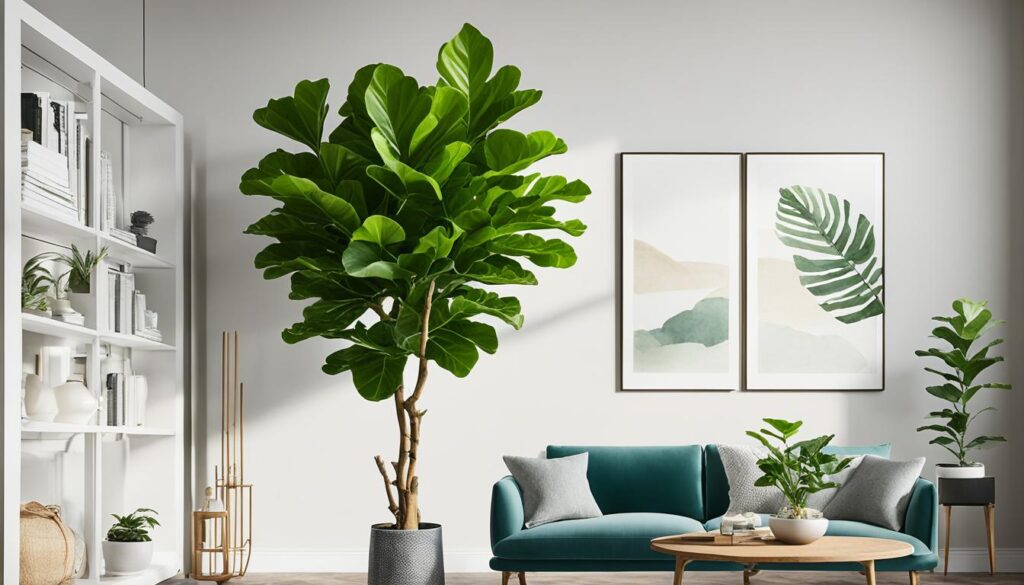
The Fiddle Leaf Fig, with its elegant leaves and impressive stature, is a true statement plant that adds a touch of botanical beauty to any interior. With the right care and attention, you can enjoy the lushness and charm of this marvelous houseplant.
The Exotic Classic: Monstera Deliciosa Care Tips
The Monstera Deliciosa, also known as the Swiss Cheese Plant, is a timeless and iconic houseplant cherished for its unique foliage. With its large, glossy leaves adorned with distinctive natural perforations, this plant adds a touch of elegance and intrigue to any indoor space.
To ensure the health and vitality of your Monstera Deliciosa, it’s important to provide it with the proper care. Here are some essential tips:
- Light: Place your Monstera Deliciosa in a bright, indirect sunlight location. Direct sunlight can scorch its leaves, so it’s best to keep it away from intense rays.
- Watering: Water your Monstera Deliciosa when the top inch of soil becomes dry. It’s important not to overwater, as this can lead to root rot. Allow the soil to dry out slightly between waterings.
- Humidity: The Monstera Deliciosa thrives in humid environments. If your home has low humidity levels, consider placing a humidifier nearby or misting the leaves with water to increase moisture.
- Support: As the Monstera Deliciosa grows, it develops aerial roots that can climb and attach to structures. Providing a moss pole, trellis, or other support system will allow the plant to grow vertically and enhance its natural beauty.
With proper care and attention, your Monstera Deliciosa will flourish and become a stunning focal point in your indoor garden.
“The Monstera Deliciosa, with its unique foliage and striking appearance, brings a touch of tropical paradise to any room.” – Plant Enthusiast
Embracing the Exotic: Bird of Paradise Care Guide
The Bird of Paradise, scientifically known as Strelitzia Reginae, is a tropical masterpiece that brings a touch of the exotic to any room. With its vibrant orange and blue flowers, this plant can become a striking focal point in your indoor garden.
Proper care for the Bird of Paradise is essential to ensure its growth and longevity. Here are some essential care tips:
Light
The Bird of Paradise thrives in bright, indirect sunlight. Place it near a window where it can receive at least six hours of sunlight each day. Avoid exposing it to direct sunlight for extended periods, as it can burn the leaves.
Water
Consistent moisture is crucial for the Bird of Paradise. Water the plant regularly during the growing season, ensuring the top inch of soil is evenly moist. However, avoid overwatering, as it can lead to root rot. Allow the soil to dry slightly between waterings in the dormant season.
Temperature and Humidity
The Bird of Paradise prefers warm temperatures between 65-85°F (18-29°C). It can tolerate lower temperatures, but prolonged exposure to cold drafts can damage the plant. Maintain moderate humidity levels to mimic its native tropical habitat. You can use a humidifier or place the plant on a tray with water and pebbles.
Soil
Use well-draining soil for the Bird of Paradise to prevent waterlogged conditions. A mix of peat moss, perlite, and regular potting soil works well. Ensure the pot has drainage holes to prevent water accumulation.
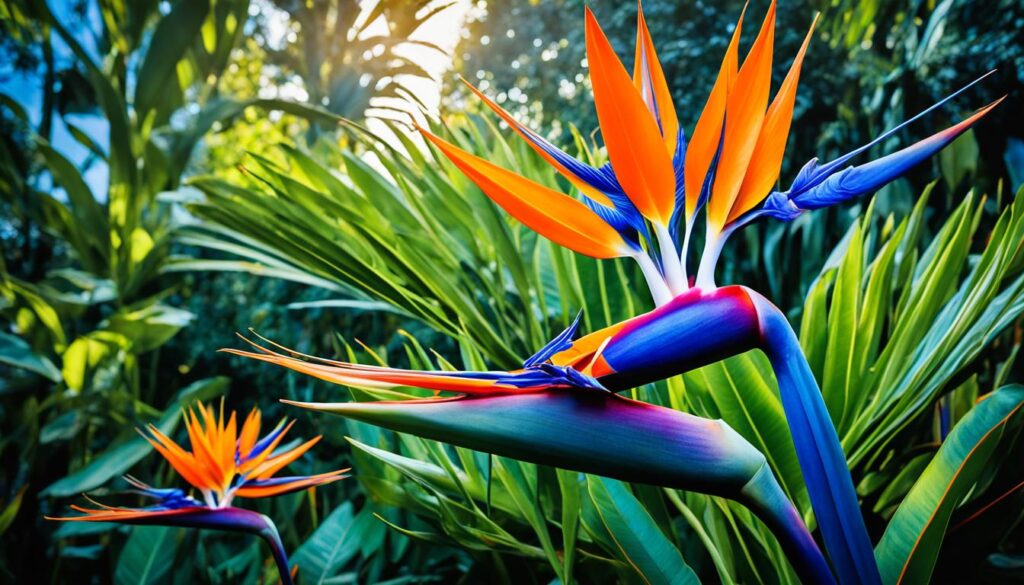
“The Bird of Paradise is a symbol of paradise, and its vibrant colors can bring joy and life to any space. With the right care, this tropical beauty can thrive and become a stunning addition to your indoor garden.” – Plant Expert
By following these care guidelines, you can successfully cultivate a flourishing Bird of Paradise in your home. Remember to periodically check for pests, remove any dead or yellowing leaves, and fertilize sparingly during the growing season. With its impressive foliage and stunning flowers, the Bird of Paradise is sure to captivate all who behold it.
Enchanting Patterns: Calathea Orbifolia Care Tips
The Calathea Orbifolia is a botanical masterpiece known for its large, round leaves with striking silvery-green stripes. This unique foliage adds an element of elegance to any indoor space, making it a favorite among plant enthusiasts.
When it comes to Calathea Orbifolia care, there are a few key factors to keep in mind. This plant thrives in medium to low light conditions, making it an excellent choice for areas with less natural light. Placing it near a north or east-facing window will provide the perfect balance of light intensity.
Consistent moisture is essential for the Calathea Orbifolia. It prefers to be kept evenly moist, but be careful not to overwater, as this can lead to root rot. Regularly check the soil moisture level and water when the top inch feels slightly dry. Mist the leaves regularly to maintain moderate humidity and recreate its natural tropical environment.
One of the fascinating features of the Calathea Orbifolia is its ability to open and close its leaves. This process, known as nyctinasty, occurs in response to the day-night cycle. The leaves open during the day to absorb maximum sunlight and close at night as a protective mechanism. Observing this dance of movement adds an enchanting touch to your indoor garden.

Tips for Calathea Orbifolia Care:
- Place the plant in medium to low light conditions, avoiding direct sunlight.
- Keep the soil evenly moist, but avoid overwatering.
- Mist the leaves regularly to maintain moderate humidity.
- Observe and appreciate the fascinating leaf movement of nyctinasty.
With proper care, the Calathea Orbifolia will reward you with its mesmerizing patterns and lush foliage. It is a stunning addition to any indoor space, providing a touch of elegance and botanical beauty.
Rare Gem: Pink Princess Philodendron Care Guide
The Pink Princess Philodendron, also known as Philodendron Erubescens, is a rare gem that never fails to captivate plant enthusiasts with its stunning beauty. This extraordinary houseplant features dark green leaves adorned with vibrant pink variegation that adds a touch of elegance and intrigue to any indoor garden.
To ensure the healthy growth of your Pink Princess Philodendron, it is essential to provide it with the right care and environment. Here are some expert tips to keep your Pink Princess Philodendron thriving:
Light
The Pink Princess Philodendron thrives in bright, indirect sunlight. Place it near a window, but ensure it is shielded from harsh, direct sunlight that can scorch its delicate leaves. If you notice the variegation fading or the plant becoming leggy, it may be an indication that it is not receiving enough light.
Watering
Proper watering is crucial for the well-being of your Pink Princess Philodendron. Keep the soil consistently moist, but be mindful not to overwater as this can lead to root rot. Allow the top inch of the soil to dry out before watering again. Remember, it’s always better to underwater than overwater.
Humidity
The Pink Princess Philodendron thrives in higher humidity levels. Mist the leaves regularly or place a humidifier nearby to create the ideal humid environment for your plant. This will help prevent the leaves from drying out and maintain their vibrant appearance.
Soil
Choose a well-draining potting mix that retains moisture without becoming soggy. A mix that combines peat moss, perlite, and organic matter will provide the Pink Princess Philodendron with the right balance of nutrients and drainage.
Fertilizer
Feed your Pink Princess Philodendron with a balanced, water-soluble fertilizer once a month during the growing season (spring and summer). Dilute the fertilizer to half the recommended strength to avoid burning the roots. Refrain from fertilizing during the winter months when the plant is in its dormant phase.
Propagation
If you wish to expand your collection of Pink Princess Philodendrons or share this beauty with a fellow plant lover, propagation is an excellent option. It can be propagated through stem cuttings or by air layering. For stem cuttings, select a healthy stem with a few leaves and place it in a glass of water or directly in a potting mix until roots develop.
Potting and Repotting
Choose a pot that allows for proper drainage and has enough room for the plant’s roots to grow. Repot your Pink Princess Philodendron every two years or when it outgrows its current pot. Spring is an ideal time for repotting when the plant is experiencing active growth.
Common Issues
Like any other houseplant, the Pink Princess Philodendron can face a few problems. Here are some common issues and how to address them:
| Issue | Solution |
|---|---|
| Yellowing leaves | This could be a sign of overwatering. Adjust your watering routine and ensure the soil has proper drainage. |
| Brown spots on leaves | Exposure to direct sunlight or low humidity levels can cause these spots. Move the plant to a location with filtered light and increase humidity. |
| Lack of variegation | If the pink variegation starts fading, it may indicate insufficient light exposure. Move the plant to a brighter spot, but avoid direct sunlight. |
With its remarkable visual appeal and relatively low-maintenance nature, the Pink Princess Philodendron is an ideal choice for both beginners and experienced plant enthusiasts. By providing it with the right amount of light, water, humidity, and care, you can enjoy the beauty and elegance of this rare gem in your indoor garden.
Creating a Pet-Friendly Oasis with Exotic Houseplants
As pet owners, it’s important to choose houseplants that are safe for our furry friends. Fortunately, many exotic houseplants can coexist with pets if certain precautions are taken. By selecting pet-friendly houseplants, you can enhance your living space while keeping your pets safe and happy.
- Spider Plant: This popular houseplant not only adds a touch of greenery to your home but is also non-toxic to cats and dogs. It’s easy to care for, making it a perfect choice for beginner plant parents.
- Calathea: Known for their stunning foliage and intricate patterns, Calathea plants are safe for pets. With their air-purifying qualities, they create a healthy and pet-friendly environment.
- Ferns: Ferns, such as the Boston Fern and Maidenhair Fern, are safe and non-toxic to pets. They thrive in a variety of light conditions and add a lush, tropical feel to any room.
- Pilea: Also known as the Friendship Plant, Pilea is a pet-safe houseplant with round, coin-shaped leaves. It’s a low-maintenance option that adds a touch of charm to your indoor oasis.
- Peperomia: With their compact size and attractive foliage, Peperomia plants are a great choice for pet owners. They come in a variety of leaf shapes and colors, adding visual interest to your space.
- African Violet: Known for their vibrant flowers and compact size, African Violets are safe for pets. They are relatively easy to care for and can brighten up any corner of your home.
By incorporating these pet-safe houseplants into your indoor garden, you can create a pet-friendly oasis where your plants and pets can thrive together harmoniously.
“Pets and plants can coexist peacefully with the right choices. By selecting pet-friendly houseplants, you can create a lush and vibrant space without compromising the safety of your furry friends.”
Image:
Easy-to-Care-for Exotic Houseplants
Not all exotic houseplants require intensive care. There are many easy-to-care-for options that can thrive in various indoor environments. These plants, such as Snake Plant, ZZ Plant, and Pothos, are known for their resilience and adaptability. By incorporating these low-maintenance houseplants into your indoor garden, you can enjoy the benefits of greenery without the stress of complex care routines.
Easy-to-care-for plants are perfect for beginners or individuals with busy lifestyles who still want to enjoy the beauty and benefits of indoor plants. These varieties are not only visually appealing but also require minimal attention, making them ideal for those who may not have a green thumb or a lot of time to invest in plant care. By choosing low-maintenance houseplants, you can effortlessly enhance your living space with vibrant greenery.
Easy-to-Care-for Houseplant Options:
- Snake Plant (Sansevieria): This plant is renowned for its durability and ability to thrive in low light conditions. It can withstand infrequent watering and is known for its air-purifying qualities.
- ZZ Plant (Zamioculcas zamiifolia): The ZZ Plant is an excellent option for low-light environments and has a striking appearance with its glossy, dark green leaves. It requires minimal watering and is highly tolerant of neglect.
- Pothos (Epipremnum aureum): Pothos is a popular choice for its trailing vines and variegated leaves. It can adapt to a variety of lighting conditions and thrives with minimal maintenance.
These easy-to-care-for houseplants not only add aesthetic appeal to your indoor spaces but also improve air quality by removing toxins and releasing oxygen. They can help lower stress levels and create a calming environment. With their resilience and adaptability, these plants are perfect for adding a touch of nature to any home or office.
In the next section, we will explore practical tips for creating a pet-friendly oasis with exotic houseplants. Learn how to choose plants that are safe for your furry friends without compromising on style or beauty.
Conclusion
Caring for exotic houseplants can be a rewarding and enjoyable experience. By understanding the specific needs of these plants and providing them with the right conditions, you can create a thriving indoor garden filled with unique and beautiful flora.
When it comes to exotic houseplant care, it’s important to choose plants that suit your lifestyle and the environment you can provide. If you have pets, opt for pet-friendly plants to ensure their safety. For those new to indoor gardening, selecting low-maintenance options like Snake Plant, ZZ Plant, and Pothos can make the process easier.
With the right care and attention, you can create a green oasis in your home or office. Indoor gardening not only adds beauty to your space but also improves air quality, reduces stress levels, and enhances well-being. So go ahead, embrace the world of exotic houseplants and let them transform your living space into a vibrant and tranquil sanctuary.
For more valuable Expert Tips check out our comprehensive Houseplant Guide to Tips for Indoor Plant Care.
If you happen to be nearby, stop in at The Landscape Connection and say Hi. Michelle and I would love to meet you.
FAQ
Why should I consider adding exotic houseplants to my indoor space?
Exotic houseplants not only add a touch of beauty to our indoor spaces but also provide a range of benefits. They help improve indoor air quality by filtering out pollutants and producing oxygen. Additionally, they can reduce stress, enhance mood, and increase productivity.
How do I care for a Fiddle Leaf Fig?
Proper care for the Fiddle Leaf Fig includes providing bright, indirect sunlight, watering it when the top inch of soil is dry, and maintaining adequate humidity levels.
What are the care requirements for a Monstera Deliciosa?
The Monstera Deliciosa thrives in bright, indirect sunlight and requires regular watering when the top inch of soil becomes dry.
How can I care for a Bird of Paradise?
The Bird of Paradise requires bright, indirect sunlight and consistent moisture during the growing season.
What are the care instructions for a Calathea Orbifolia?
The Calathea Orbifolia thrives in medium to low light conditions and requires consistent moisture and moderate humidity. It also has the fascinating ability to open and close its leaves in response to the day-night cycle.
How do I care for a Pink Princess Philodendron?
The Pink Princess Philodendron thrives in bright, indirect sunlight and requires regular watering while ensuring the soil doesn’t completely dry out.
Are there any exotic houseplants that are safe for pets?
Yes, there are several pet-friendly options including Spider Plant, Calathea, Ferns, Pilea, Peperomia, and African Violet.
Are there any exotic houseplants that are easy to care for?
Yes, there are many low-maintenance options that can thrive in various indoor environments, such as Snake Plant, ZZ Plant, and Pothos.
How do I create the ideal conditions for my exotic houseplants?
Understanding the specific needs of each plant is crucial. Providing the right light, water, humidity, and temperature levels is essential for their well-being and growth.
How can I incorporate exotic houseplants into my indoor garden?
Start by choosing plants that match your lifestyle and the conditions of your space. Consider their care requirements and the visual appeal they bring to your indoor garden.


